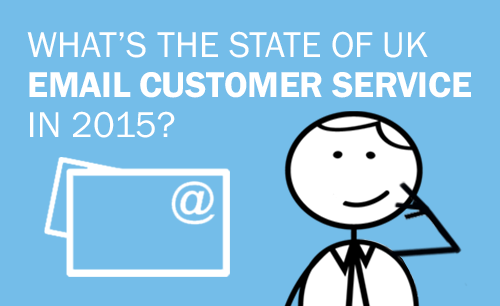What’s the state of UK email customer service in 2015?

Eptica recently released the 2015 Multichannel Customer Experience Study, looking at the state of customer service provided by leading UK brands across the web, email, Twitter and chat channels. We’ve already discussed the topline findings of the Study in a previous blog, and this week I’d like to focus on the email channel, and how this has changed over time.
Despite the rise of social media, email is still the primary digital channel used by consumers to communicate with brands. Expectations are rising – customers want a fast response that delivers a consistent, personalised answer to their question, without them needing to make contact again or change channel.
2015 UK Email Customer Service
As part of the Eptica Multichannel Customer Experience Study 100 brands were emailed a single, sector-specific question that was designed to replicate actual customer queries. For example telecoms providers were asked if they had a 24 hour customer service line and electronics companies how an out of warranty product could be repaired. They were then measured on the speed of their response and whether it answered the question that was asked. The Study repeats research carried out for the last four years, providing visibility of how performance has changed over time.
There were two main positives that can be taken from the 2015 results. Firstly, more companies (74%) provided contact details (either through an email address or a web form) that let non-customers email them, an increase of 3% over 2014. Secondly, the average time to receive an answer dropped dramatically, from 61 hours 39 minutes to 29 hours 27 minutes. Essentially customers receive a response over a day faster than last year.
Unfortunately, this is where the good news stops. Answers may have been faster, but they were less likely to be accurate – or, indeed, to be received at all. Of the 74% of companies that offered email, only 59% actually answered. This means that 15 companies lost, ignored or simply failed to respond to basic customer questions.
The email lottery
And of the 59 brands that answered only 39 successfully answered the question. So one fifth of companies went to the effort of responding didn’t give a useful answer. This has a two-fold effect – it will annoy customers who are forced to re-contact a company, and also pushes up costs. Companies have gone through the process of receiving an email, allocating it to an agent, and then writing and sending an answer that is not correct or relevant. This is a tremendous waste of resources – particularly if the consumer sends a follow-up email that means the company has to repeat the whole exercise.
The 39% success rate of email means that it is the least likely channel to receive a useful answer on, behind Twitter (41%) and the web (64%). Last year the positions of email and Twitter were reversed, with 41% of email questions successfully answered. This shows that the resources assigned to this channel haven’t increased to meet rising demand, and that companies are not taking advantage of technology, such as workflow, linguistics and knowledge management, that could help them master the email deluge.
Greater customer expectations
The overall picture on email customer service, while poor, does mask big differences between best and worst:
- 80% of electronics retailers successfully answered questions emailed to them – against 10% of travel companies and banks.
- One fashion retailer responded successfully in 9 minutes – another took 68 hours.
- Response times varied from 9 minutes to 30 days, an enormous disparity between the strongest and weakest companies on email.
Customer expectations are growing continually, meaning that even those companies that successfully responded quickly in 2015 need to ensure that they carry on improving. Research from Forrester found that 41% of consumers expect a response to their email within 6 hours – only 16% of companies achieved this, showing that there is still a gap to be bridged between expectations and reality.
Overall email performance in 2015 was mixed – speed improved, but accuracy worsened. Given that it is a central channel for customer service, all companies need to focus on email and allocate the right resources and technology to ensure that customer expectations are met, both now and in the future.






